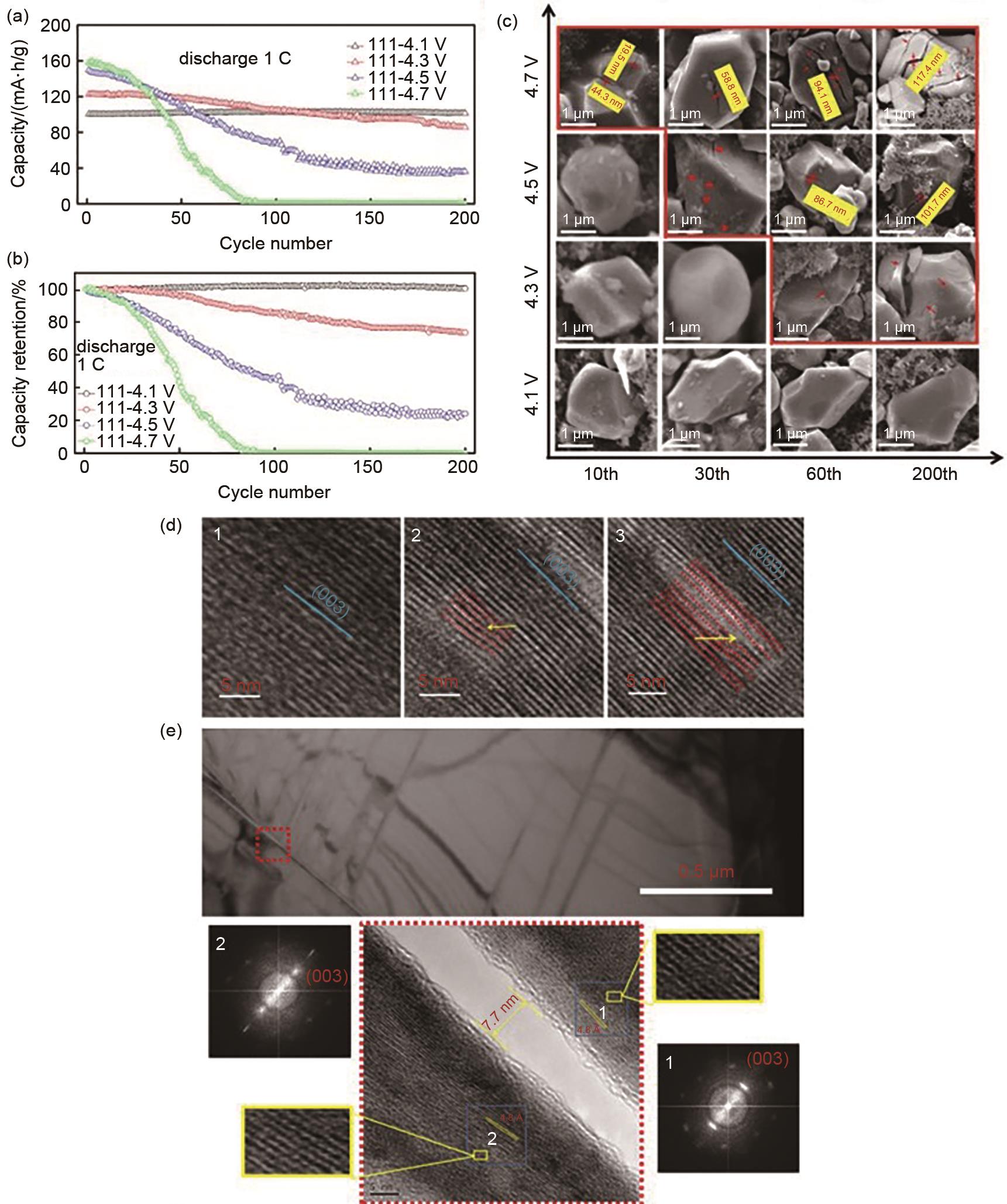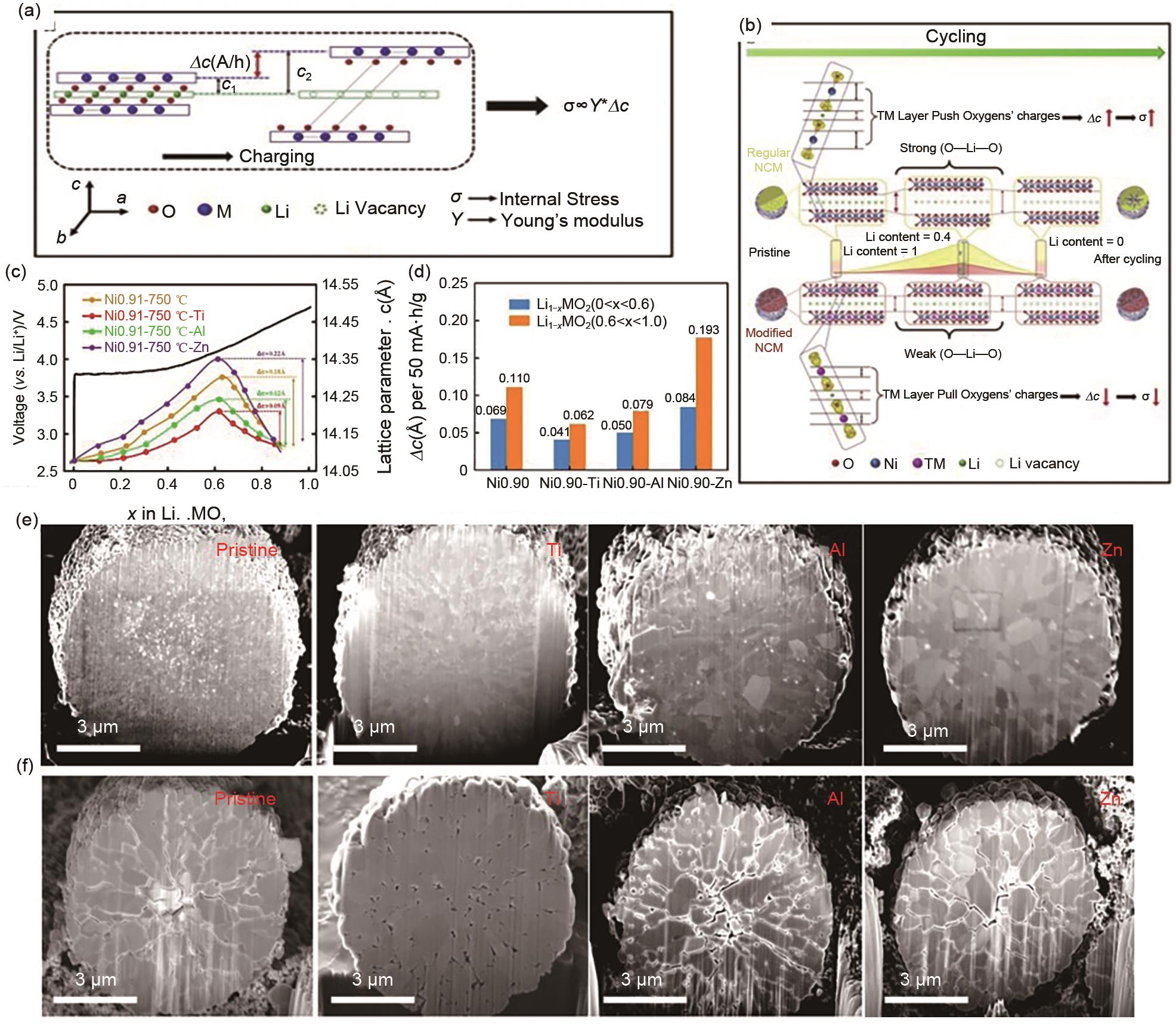Energy Storage Science and Technology ›› 2022, Vol. 11 ›› Issue (3): 948-956.doi: 10.19799/j.cnki.2095-4239.2022.0001
Previous Articles Next Articles
Zhongmin REN( ), Bin WANG, Shuaishuai CHEN, Hua LI, Zhenlian CHEN, Deyu WANG(
), Bin WANG, Shuaishuai CHEN, Hua LI, Zhenlian CHEN, Deyu WANG( )
)
Received:2022-01-03
Revised:2022-01-15
Online:2022-03-05
Published:2022-03-11
Contact:
Deyu WANG
E-mail:2310809000@qq.com;wangdeyu@jhun.edu.cn
CLC Number:
Zhongmin REN, Bin WANG, Shuaishuai CHEN, Hua LI, Zhenlian CHEN, Deyu WANG. Mechanics-induced degradation on layer-structured cathodes and remedies to address it[J]. Energy Storage Science and Technology, 2022, 11(3): 948-956.

Fig. 3
Analysis of cyclic stability and microscopy on LiNi1/3Co1/3Mn1/3O2 with various cut-off potentials: (a) reversible capacities under 1 C; (b) capacity retention ratio under 1 C; (c) SEM images at 10, 30, 60, 200 cycles with various cut-off potentials. HRTEM images at 0, 10, 30 (d) and 200 (e) cycles with cut-off potential of 4.3 V"


Fig. 5
Influence of suppressing lattice variation on cyclic stability: (a) mechanism of mechanical damage; (b) relationship among the O’s charges, mechanical stress and particle cracking; (c) variation of lattice c on all investigated samples during charge; and (d) Δc per 50 mA·h/g in two distinct phase transitions of all investigated samples; SEM cross section images of (e) Ni0.90 and (f) Ni0.90-Ti, Ni0.90-Al & Ni0.90-Zn dopant samples after 0 & 200 cycles in the pouch full cell"


Fig. 7
Post-analysis on electrodes and particles of the pristine and Nb-modified sample with microscopy: (a, e) SEM images of NCM811 and NCM811-NW; (b, f) Cross-section SEM images of NCM811 and NCM811-NW; (c, g) Magnified TEM images of NCM811 and NCM811-NW, (d, h) High resolution TEM images and FFT images (inset) of NCM811 and NCM811-NW the marked red oval regions in (c) and (g); (i) The schematic illustration of microcrack surface change after cycling. The green dots represent crack, the purple rings represent the shell, the yellow arrow curve represents the electrolyte"

| 1 | LEE W, MUHAMMAD S, KIM T, et al. New insight into Ni-rich layered structure for next-generation Li rechargeable batteries[J]. Advanced Energy Materials, 2018, 8(4): doi: 10.1002aenm.201701788. |
| 2 | 张利强, 唐永福, 刘秋男, 等. 原位透射电镜技术在电池领域的研究进展[J]. 储能科学与技术, 2019, 8(6): 1050-1061. |
| ZHANG L Q, TANG Y F, LIU Q N, et al. Review of in situ transmission electron microscopy studies of battery materials[J]. Energy Storage Science and Technology, 2019, 8(6): 1050-1061. | |
| 3 | 葛昊, 李哲, 张剑波. 锂离子电池开路电压曲线形状与多阶段容量损失[J]. 储能科学与技术, 2019, 8(6): 1089-1095. |
| GE H, LI Z, ZHANG J B. Multi-stage capacity loss of lithium-ion batteries originating from the multi-slope nature of open circuit voltage curves[J]. Energy Storage Science and Technology, 2019, 8(6): 1089-1095. | |
| 4 | 樊亚平, 晏莉琴, 简德超, 等. 锂离子电池失效中析锂现象的原位检测方法综述[J]. 储能科学与技术, 2019, 8(6): 1040-1049. |
| FAN Y P, YAN L Q, JIAN D C, et al. In situ detection of lithium dendrite in the failure of lithium-ion batteries[J]. Energy Storage Science and Technology, 2019, 8(6): 1040-1049. | |
| 5 | 张杰男, 汪君洋, 吕迎春, 等. 锂电池研究中的X射线多晶衍射实验与分析方法综述[J]. 储能科学与技术, 2019, 8(3): 443-467. |
| ZHANG J N, WANG J Y, LYU Y C, et al. Experimental measurement and analysis methods of polycrystalline X-ray diffraction for lithium batteries[J]. Energy Storage Science and Technology, 2019, 8(3): 443-467. | |
| 6 | 陈晓轩, 李晟, 胡泳钢, 等. 锂离子电池三元层状氧化物正极材料失效模式分析[J]. 储能科学与技术, 2019, 8(6): 1003-1016. |
| CHEN X X, LI S, HU Y G, et al. Failure mechanism of Li1+ x(NCM)1- xO2 layered oxide cathode material during capacity degradation[J]. Energy Storage Science and Technology, 2019, 8(6): 1003-1016. | |
| 7 | AURBACH D. Electrode-solution interactions in Li-ion batteries: A short summary and new insights[J]. Journal of Power Sources, 2003, 119/120/121: 497-503. |
| 8 | BIANCHINI M, ROCA-AYATS M, HARTMANN P, et al. There and back again-the journey of LiNiO2 as a cathode active material[J]. Angewandte Chemie, 2019, 58(31): 10434-10458. |
| 9 | XU Z R, RAHMAN M M, MU L Q, et al. Chemomechanical behaviors of layered cathode materials in alkali metal ion batteries[J]. Journal of Materials Chemistry A, 2018, 6(44): 21859-21884. |
| 10 | 李守涛, 孟庆函, 阮一钊, 等. Li(Ni1/3Co1/3Mn1/3)O2/graphite电池在备用电源工况下的交流阻抗[J]. 储能科学与技术, 2019, 8(6): 1171-1175. |
| LI S T, MENG Q H, RUAN Y Z, et al. AC impedance of Li(Ni1/3co1/3Mn1/3)o2/graphite cell as UPS[J]. Energy Storage Science and Technology, 2019, 8(6): 1171-1175. | |
| 11 | 孔令丽, 张克军, 夏晓萌, 等. 高电压锂离子电池高温浮充性能影响因素分析与改善[J]. 储能科学与技术, 2019, 8(6): 1165-1170. |
| KONG L L, ZHANG K J, XIA X M, et al. Analysis and improvement of high temperature floating charge performance for high voltage lithium ion batteries[J]. Energy Storage Science and Technology, 2019, 8(6): 1165-1170. | |
| 12 | 拱越, 谷林. 锂离子电池材料的电子显微学分析方法[J]. 储能科学与技术, 2019, 8(6): 1260-1270. |
| GONG Y, GU L. Transmission electron microscopy of lithium ion battery materials[J]. Energy Storage Science and Technology, 2019, 8(6): 1260-1270. | |
| 13 | 陈天雨, 高尚, 冯旭宁, 等. 锂离子电池热失控蔓延研究进展[J]. 储能科学与技术, 2018, 7(6): 1030-1039. |
| CHEN T Y, GAO S, FENG X N, et al. Recent progress on thermal runaway propagation of lithium-ion battery[J]. Energy Storage Science and Technology, 2018, 7(6): 1030-1039. | |
| 14 | 任东生, 冯旭宁, 韩雪冰, 等. 锂离子电池全生命周期安全性演变研究进展[J]. 储能科学与技术, 2018, 7(6): 957-966. |
| REN D S, FENG X N, HAN X B, et al. Recent progress on evolution of safety performance of lithium-ion battery during aging process[J]. Energy Storage Science and Technology, 2018, 7(6): 957-966. | |
| 15 | 冯小龙, 杨乐, 张明亮, 等. 锂离子电池内部力学与温度参量在位表征方法[J]. 储能科学与技术, 2019, 8(6): 1062-1075. |
| FENG X L, YANG L, ZHANG M L, et al. Failure mechanics inner lithium ion batteries: In-situ multi-field experimental methods[J]. Energy Storage Science and Technology, 2019, 8(6): 1062-1075. | |
| 16 | KIM U H, KIM J H, HWANG J Y, et al. Compositionally and structurally redesigned high-energy Ni-rich layered cathode for next-generation lithium batteries[J]. Materials Today, 2019, 23: 26-36. |
| 17 | 耿福山, 胡炳文. 锂离子电池中重要正极材料体系的磁共振研究进展[J]. 储能科学与技术, 2019, 8(6): 1017-1023. |
| GENG F S, HU B W. Progress in magnetic resonance research of important cathode materials in lithium ion batteries[J]. Energy Storage Science and Technology, 2019, 8(6): 1017-1023. | |
| 18 | 许高洁, 王晓, 陆迪, 等. 锂离子电池高安全性阻燃电解液研究进展[J]. 储能科学与技术, 2018, 7(6): 1040-1059. |
| XU G J, WANG X, LU D, et al. Research progress of high safety flame retardant electrolytes for lithium-ion batteries[J]. Energy Storage Science and Technology, 2018, 7(6): 1040-1059. | |
| 19 | WANG D Y, WU X D, WANG Z X, et al. Cracking causing cyclic instability of LiFePO4 cathode material[J]. Journal of Power Sources, 2005, 140(1): 125-128. |
| 20 | BI Y J, YANG W C, DU R, et al. Correlation of oxygen non-stoichiometry to the instabilities and electrochemical performance of LiNi0.8Co0.1Mn0.1O2 utilized in lithium ion battery[J]. Journal of Power Sources, 2015, 283: 211-218. |
| 21 | FENG X N, HE X M, OUYANG M G, et al. Thermal runaway propagation model for designing a safer battery pack with 25 A·h LiNixCoyMnzO2 large format lithium ion battery[J]. Applied Energy, 2015, 154: 74-91. |
| 22 | JIANG L H, WANG Q S, SUN J H. Electrochemical performance and thermal stability analysis of LiNixCoyMnzO2 cathode based on a composite safety electrolyte[J]. Journal of Hazardous Materials, 2018, 351: 260-269. |
| 23 | XU J, HU E Y, NORDLUND D, et al. Understanding the degradation mechanism of lithium nickel oxide cathodes for Li-ion batteries[J]. ACS Applied Materials & Interfaces, 2016, 8(46): 31677-31683. |
| 24 | REN Z M, ZHANG X H, LIU M, et al. Constant dripping wears away a stone: Fatigue damage causing particles' cracking[J]. Journal of Power Sources, 2019, 416: 104-110. |
| 25 | YIN S Y, DENG W T, CHEN J, et al. Fundamental and solutions of microcrack in Ni-rich layered oxide cathode materials of lithium-ion batteries[J]. Nano Energy, 2021, 83: doi: 10.1016/j.nanoen. 2021.105854. |
| 26 | ZHANG X H, CHEN Z L, SCHWARZ B, et al. Kinetic characteristics up to 4.8 V of layered LiNi1/3Co1/3Mn1/3O2 cathode materials for high voltage lithium-ion batteries[J]. Electrochimica Acta, 2017, 227: 152-161. |
| 27 | RYU H H, PARK K J, YOON D R, et al. Li[Ni0.9Co0.09W0.01]O2: A new type of layered oxide cathode with high cycling stability[J]. Advanced Energy Materials, 2019, 9(44): doi: 10.1002/aenm. 201902698. |
| 28 | LIU M, REN Z M, WANG D Y, et al. Addressing unfavorable influence of particle cracking with a strengthened shell layer in Ni-rich cathodes[J]. ACS Applied Materials & Interfaces, 2021, 13(16): 18954-18960. |
| [1] | Chengzhi KE, Bensheng XIAO, Miao LI, Jingyu LU, Yang HE, Li ZHANG, Qiaobao ZHANG. Research progress in understanding of lithium storage behavior and reaction mechanism of electrode materials through in situ transmission electron microscopy [J]. Energy Storage Science and Technology, 2021, 10(4): 1219-1236. |
| [2] | Dechao GUO, Yimin GUO, Qiwen ZHANG, Xiangyun CI, Fengrong HE. Preparation and characterization of solvent-free dry electrodes for lithium ion batteries [J]. Energy Storage Science and Technology, 2021, 10(4): 1311-1316. |
| [3] | Yilong LIN, Min XIAO, Dongmei HAN, Shuanjin WANG, Yuezhong MENG. Research progress in formation technique for LIBs [J]. Energy Storage Science and Technology, 2021, 10(1): 50-58. |
| [4] | Taihua WANG, Shujie ZHANG, Jin'gan CHEN. Low temperature charging performance optimization of lithium battery based on BP-PSO Algorithm [J]. Energy Storage Science and Technology, 2020, 9(6): 1940-1947. |
| [5] | Xintong LI, Linchen ZHANG, Huanrui ZHANG, Botao ZHANG, Guanglei CUI. Research progress of liquid-crystalline electrolytes in lithium ion batteries [J]. Energy Storage Science and Technology, 2020, 9(6): 1595-1605. |
| [6] | Xingang MA, Yuwei ZANG, Lianke XIE, Jianguang YIN, Guoying ZHANG, Rongchun MA, Xianzheng YUAN. Engineering pseudocapacitive lithium storage based on ultra-fine SnS2-carbon3D microstructure [J]. Energy Storage Science and Technology, 2020, 9(5): 1467-1471. |
| [7] | Xuejiao NIE, Jinzhi GUO, Meiyi WANG, Zhenyi GU, Xinxin ZHAO, Xu YANG, Haojie LIANG, Xinglong WU. Using spent lithium manganate to prepare Li0.25Na0.6MnO2 as cathode material in sodium-ion batteries [J]. Energy Storage Science and Technology, 2020, 9(5): 1402-1409. |
| [8] | MA Tengfei, MA Chao, SUN Rui, JI Hongmei, YANG Gang. Freeze-drying assisted synthesis of mno/reduced graphene composite and the improved rate cyclic performance for lithium ion batteries [J]. Energy Storage Science and Technology, 2020, 9(4): 1044-1051. |
| [9] | WANG Taihua, ZHANG Shujie, CHEN Jingan. Low temperature charging aging modeling and optimization of charging strategy for lithium batteries [J]. Energy Storage Science and Technology, 2020, 9(4): 1137-1146. |
| [10] |
ZOU Jian, WANG Bojun, YANG Jiachao, NIU Xiaobin, WANG Liping.
Electrochemical performance of β-Li0.3V2O5 as a lithium-ion battery cathode material
[J]. Energy Storage Science and Technology, 2020, 9(2): 353-360.
|
| [11] | ZHOU Xiaolong, OU Xuewu, LIU Qirong, TANG Yongbing. Research progress on dual-ion batteries [J]. Energy Storage Science and Technology, 2020, 9(2): 551-568. |
| [12] | MAO Shulan, WU Qian, WANG Zhuoya, LU Yingying. Research progress on high-voltage electrolytes for ternary NCM lithium-ion batteries [J]. Energy Storage Science and Technology, 2020, 9(2): 538-550. |
| [13] | CHEN Xiaoxia, LIU Kai, WANG Baoguo. Research on high-safety electrolytes and their application in lithium-ion batteries [J]. Energy Storage Science and Technology, 2020, 9(2): 583-592. |
| [14] | GUAN Yibiao, SHEN Jinran, LI Kangle, GUAN Zhaoruxin, ZHOU Shuqin, GUO Cuijing, XU Bin. Application of graphene conductive additives in cathodes of lithium ion batteries [J]. Energy Storage Science and Technology, 2020, 9(1): 70-81. |
| [15] | LIU Xingwen, HE Jinxin, WANG Hailin, JIN Chengyou, MIAO Yonghua, XUE Chi. Preparation and electrochemical performance of F-doped SiO@C composite material [J]. Energy Storage Science and Technology, 2019, 8(S1): 56-59. |
| Viewed | ||||||
|
Full text |
|
|||||
|
Abstract |
|
|||||
